Research Methods and Analytics for Business: T&D Program at TESCO PLC
VerifiedAdded on 2022/12/15
|11
|2774
|273
Report
AI Summary
This report investigates the impact of training and development (T&D) programs on employee performance within TESCO PLC. It begins with an introduction outlining the background, aims, objectives, research questions, rationale, and significance of the study. A literature review synthesizes existing research on the benefits of T&D, including increased productivity, competitive advantage, and improved employee retention. The research methodology section details the qualitative research approach, interpretivist philosophy, and data collection methods, including surveys and secondary data analysis. The sampling strategy involves a random sample of 30 TESCO employees, and thematic analysis is used for data analysis. The report addresses reliability, validity, limitations, and ethical considerations. The conclusion summarizes the key findings, emphasizing the positive impact of T&D on employee morale, productivity, and the company's ability to compete globally. The study uses thematic analysis to analyze the data collected from the random sample of 30 employees of the TESCO PLC. The report also includes the published book, reference and timeline for the study.
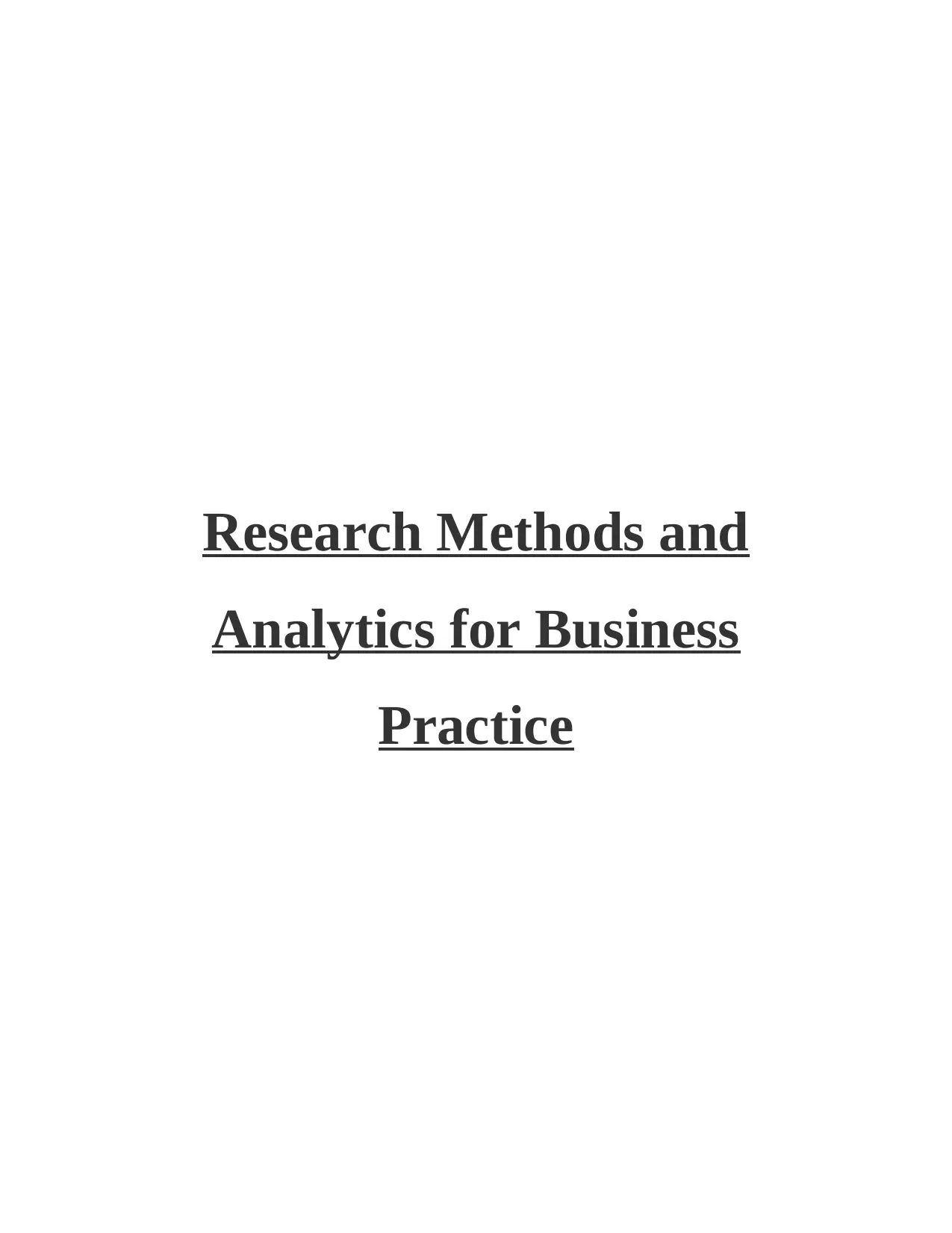
Research Methods and
Analytics for Business
Practice
Analytics for Business
Practice
Paraphrase This Document
Need a fresh take? Get an instant paraphrase of this document with our AI Paraphraser
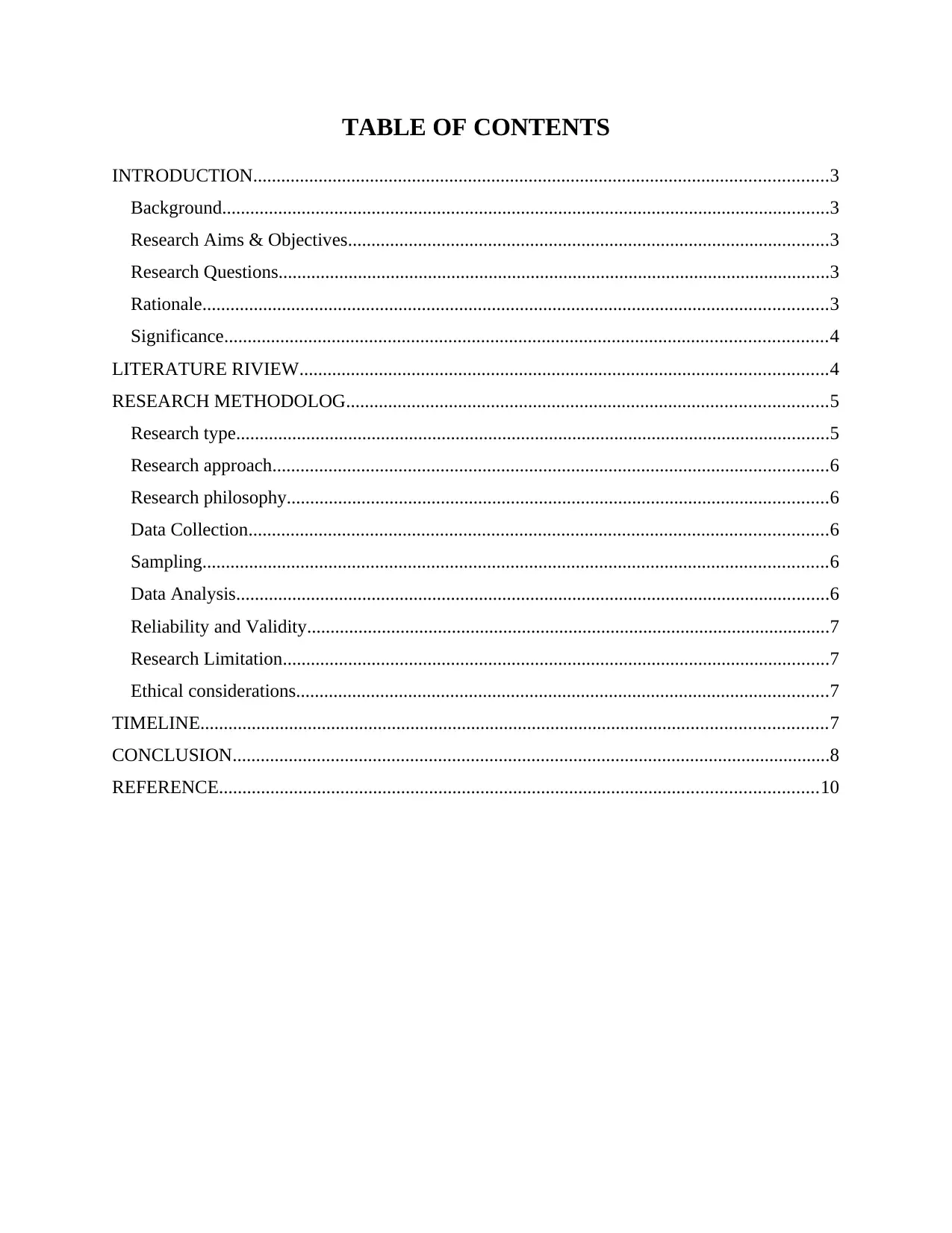
TABLE OF CONTENTS
INTRODUCTION...........................................................................................................................3
Background..................................................................................................................................3
Research Aims & Objectives.......................................................................................................3
Research Questions......................................................................................................................3
Rationale......................................................................................................................................3
Significance.................................................................................................................................4
LITERATURE RIVIEW.................................................................................................................4
RESEARCH METHODOLOG.......................................................................................................5
Research type...............................................................................................................................5
Research approach.......................................................................................................................6
Research philosophy....................................................................................................................6
Data Collection............................................................................................................................6
Sampling......................................................................................................................................6
Data Analysis...............................................................................................................................6
Reliability and Validity................................................................................................................7
Research Limitation.....................................................................................................................7
Ethical considerations..................................................................................................................7
TIMELINE......................................................................................................................................7
CONCLUSION................................................................................................................................8
REFERENCE................................................................................................................................10
INTRODUCTION...........................................................................................................................3
Background..................................................................................................................................3
Research Aims & Objectives.......................................................................................................3
Research Questions......................................................................................................................3
Rationale......................................................................................................................................3
Significance.................................................................................................................................4
LITERATURE RIVIEW.................................................................................................................4
RESEARCH METHODOLOG.......................................................................................................5
Research type...............................................................................................................................5
Research approach.......................................................................................................................6
Research philosophy....................................................................................................................6
Data Collection............................................................................................................................6
Sampling......................................................................................................................................6
Data Analysis...............................................................................................................................6
Reliability and Validity................................................................................................................7
Research Limitation.....................................................................................................................7
Ethical considerations..................................................................................................................7
TIMELINE......................................................................................................................................7
CONCLUSION................................................................................................................................8
REFERENCE................................................................................................................................10
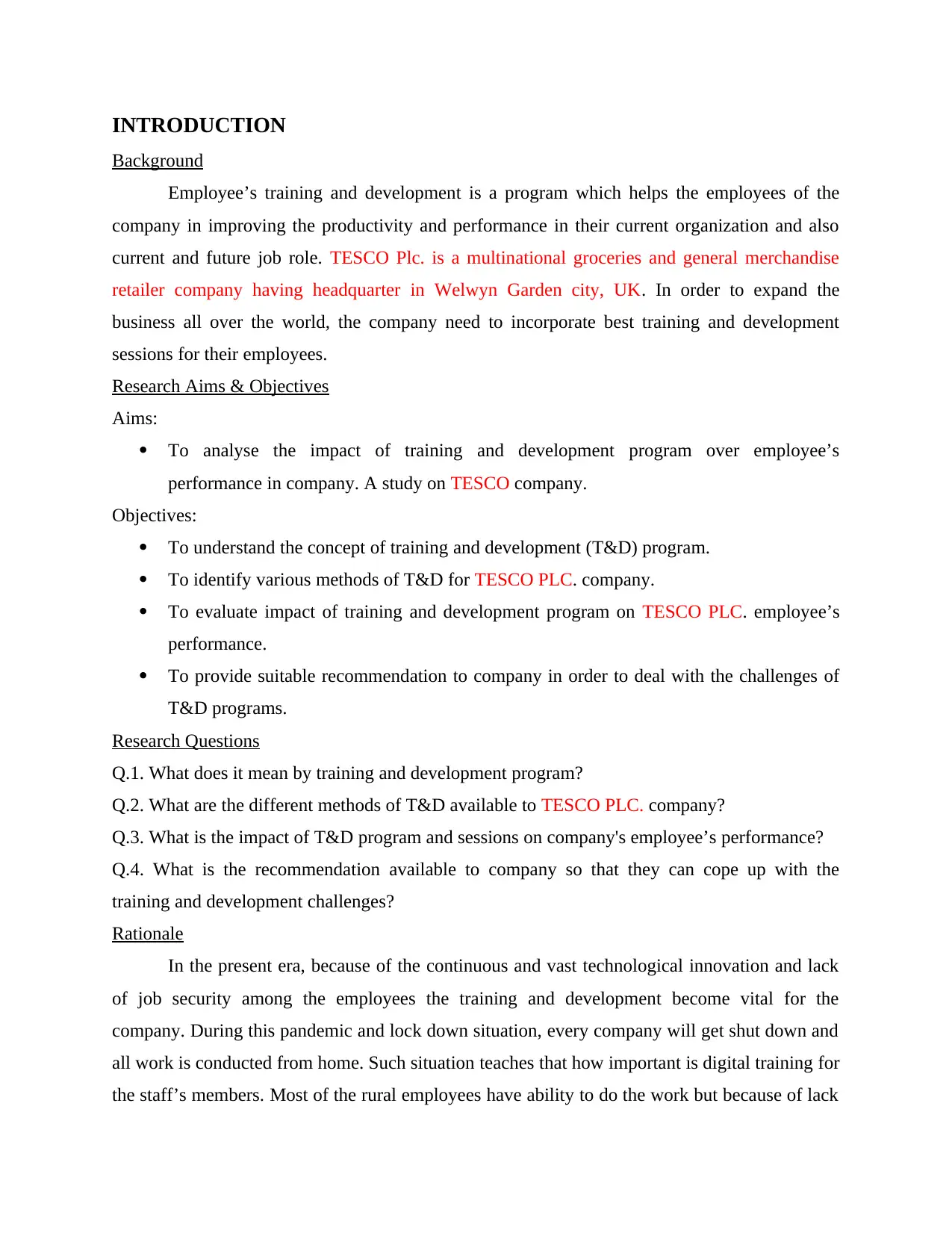
INTRODUCTION
Background
Employee’s training and development is a program which helps the employees of the
company in improving the productivity and performance in their current organization and also
current and future job role. TESCO Plc. is a multinational groceries and general merchandise
retailer company having headquarter in Welwyn Garden city, UK. In order to expand the
business all over the world, the company need to incorporate best training and development
sessions for their employees.
Research Aims & Objectives
Aims:
To analyse the impact of training and development program over employee’s
performance in company. A study on TESCO company.
Objectives:
To understand the concept of training and development (T&D) program.
To identify various methods of T&D for TESCO PLC. company.
To evaluate impact of training and development program on TESCO PLC. employee’s
performance.
To provide suitable recommendation to company in order to deal with the challenges of
T&D programs.
Research Questions
Q.1. What does it mean by training and development program?
Q.2. What are the different methods of T&D available to TESCO PLC. company?
Q.3. What is the impact of T&D program and sessions on company's employee’s performance?
Q.4. What is the recommendation available to company so that they can cope up with the
training and development challenges?
Rationale
In the present era, because of the continuous and vast technological innovation and lack
of job security among the employees the training and development become vital for the
company. During this pandemic and lock down situation, every company will get shut down and
all work is conducted from home. Such situation teaches that how important is digital training for
the staff’s members. Most of the rural employees have ability to do the work but because of lack
Background
Employee’s training and development is a program which helps the employees of the
company in improving the productivity and performance in their current organization and also
current and future job role. TESCO Plc. is a multinational groceries and general merchandise
retailer company having headquarter in Welwyn Garden city, UK. In order to expand the
business all over the world, the company need to incorporate best training and development
sessions for their employees.
Research Aims & Objectives
Aims:
To analyse the impact of training and development program over employee’s
performance in company. A study on TESCO company.
Objectives:
To understand the concept of training and development (T&D) program.
To identify various methods of T&D for TESCO PLC. company.
To evaluate impact of training and development program on TESCO PLC. employee’s
performance.
To provide suitable recommendation to company in order to deal with the challenges of
T&D programs.
Research Questions
Q.1. What does it mean by training and development program?
Q.2. What are the different methods of T&D available to TESCO PLC. company?
Q.3. What is the impact of T&D program and sessions on company's employee’s performance?
Q.4. What is the recommendation available to company so that they can cope up with the
training and development challenges?
Rationale
In the present era, because of the continuous and vast technological innovation and lack
of job security among the employees the training and development become vital for the
company. During this pandemic and lock down situation, every company will get shut down and
all work is conducted from home. Such situation teaches that how important is digital training for
the staff’s members. Most of the rural employees have ability to do the work but because of lack
⊘ This is a preview!⊘
Do you want full access?
Subscribe today to unlock all pages.

Trusted by 1+ million students worldwide
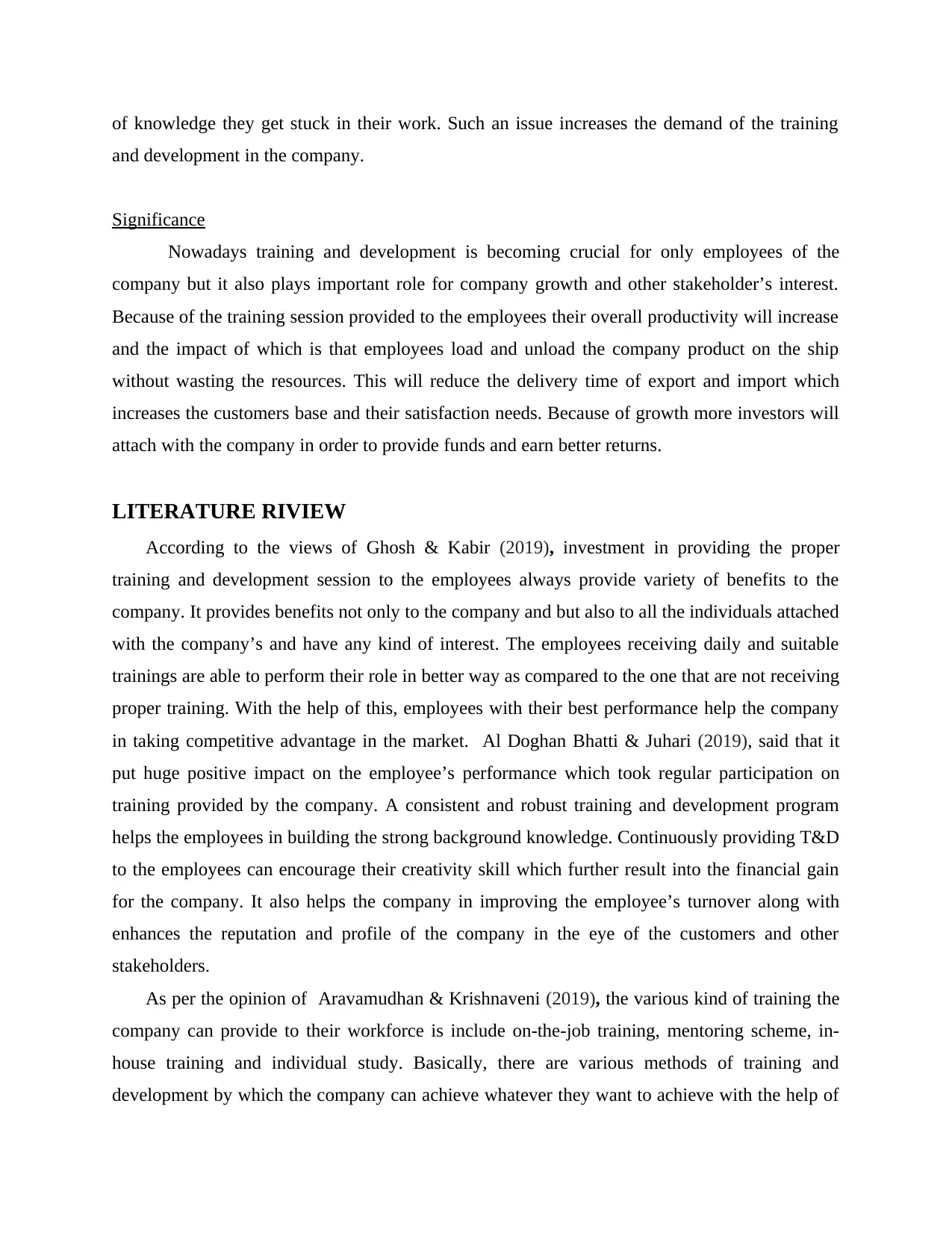
of knowledge they get stuck in their work. Such an issue increases the demand of the training
and development in the company.
Significance
Nowadays training and development is becoming crucial for only employees of the
company but it also plays important role for company growth and other stakeholder’s interest.
Because of the training session provided to the employees their overall productivity will increase
and the impact of which is that employees load and unload the company product on the ship
without wasting the resources. This will reduce the delivery time of export and import which
increases the customers base and their satisfaction needs. Because of growth more investors will
attach with the company in order to provide funds and earn better returns.
LITERATURE RIVIEW
According to the views of Ghosh & Kabir (2019), investment in providing the proper
training and development session to the employees always provide variety of benefits to the
company. It provides benefits not only to the company and but also to all the individuals attached
with the company’s and have any kind of interest. The employees receiving daily and suitable
trainings are able to perform their role in better way as compared to the one that are not receiving
proper training. With the help of this, employees with their best performance help the company
in taking competitive advantage in the market. Al Doghan Bhatti & Juhari (2019), said that it
put huge positive impact on the employee’s performance which took regular participation on
training provided by the company. A consistent and robust training and development program
helps the employees in building the strong background knowledge. Continuously providing T&D
to the employees can encourage their creativity skill which further result into the financial gain
for the company. It also helps the company in improving the employee’s turnover along with
enhances the reputation and profile of the company in the eye of the customers and other
stakeholders.
As per the opinion of Aravamudhan & Krishnaveni (2019), the various kind of training the
company can provide to their workforce is include on-the-job training, mentoring scheme, in-
house training and individual study. Basically, there are various methods of training and
development by which the company can achieve whatever they want to achieve with the help of
and development in the company.
Significance
Nowadays training and development is becoming crucial for only employees of the
company but it also plays important role for company growth and other stakeholder’s interest.
Because of the training session provided to the employees their overall productivity will increase
and the impact of which is that employees load and unload the company product on the ship
without wasting the resources. This will reduce the delivery time of export and import which
increases the customers base and their satisfaction needs. Because of growth more investors will
attach with the company in order to provide funds and earn better returns.
LITERATURE RIVIEW
According to the views of Ghosh & Kabir (2019), investment in providing the proper
training and development session to the employees always provide variety of benefits to the
company. It provides benefits not only to the company and but also to all the individuals attached
with the company’s and have any kind of interest. The employees receiving daily and suitable
trainings are able to perform their role in better way as compared to the one that are not receiving
proper training. With the help of this, employees with their best performance help the company
in taking competitive advantage in the market. Al Doghan Bhatti & Juhari (2019), said that it
put huge positive impact on the employee’s performance which took regular participation on
training provided by the company. A consistent and robust training and development program
helps the employees in building the strong background knowledge. Continuously providing T&D
to the employees can encourage their creativity skill which further result into the financial gain
for the company. It also helps the company in improving the employee’s turnover along with
enhances the reputation and profile of the company in the eye of the customers and other
stakeholders.
As per the opinion of Aravamudhan & Krishnaveni (2019), the various kind of training the
company can provide to their workforce is include on-the-job training, mentoring scheme, in-
house training and individual study. Basically, there are various methods of training and
development by which the company can achieve whatever they want to achieve with the help of
Paraphrase This Document
Need a fresh take? Get an instant paraphrase of this document with our AI Paraphraser
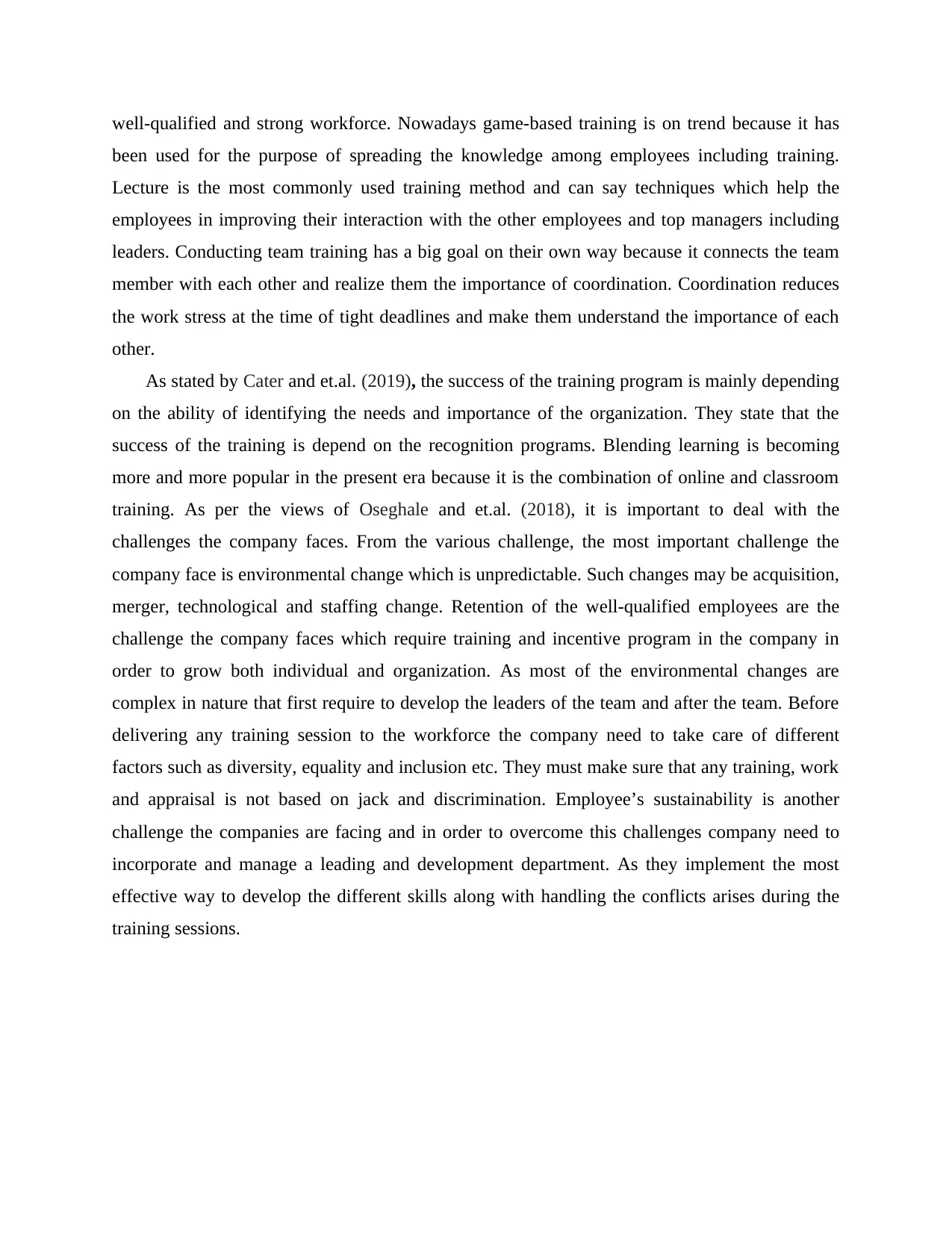
well-qualified and strong workforce. Nowadays game-based training is on trend because it has
been used for the purpose of spreading the knowledge among employees including training.
Lecture is the most commonly used training method and can say techniques which help the
employees in improving their interaction with the other employees and top managers including
leaders. Conducting team training has a big goal on their own way because it connects the team
member with each other and realize them the importance of coordination. Coordination reduces
the work stress at the time of tight deadlines and make them understand the importance of each
other.
As stated by Cater and et.al. (2019), the success of the training program is mainly depending
on the ability of identifying the needs and importance of the organization. They state that the
success of the training is depend on the recognition programs. Blending learning is becoming
more and more popular in the present era because it is the combination of online and classroom
training. As per the views of Oseghale and et.al. (2018), it is important to deal with the
challenges the company faces. From the various challenge, the most important challenge the
company face is environmental change which is unpredictable. Such changes may be acquisition,
merger, technological and staffing change. Retention of the well-qualified employees are the
challenge the company faces which require training and incentive program in the company in
order to grow both individual and organization. As most of the environmental changes are
complex in nature that first require to develop the leaders of the team and after the team. Before
delivering any training session to the workforce the company need to take care of different
factors such as diversity, equality and inclusion etc. They must make sure that any training, work
and appraisal is not based on jack and discrimination. Employee’s sustainability is another
challenge the companies are facing and in order to overcome this challenges company need to
incorporate and manage a leading and development department. As they implement the most
effective way to develop the different skills along with handling the conflicts arises during the
training sessions.
been used for the purpose of spreading the knowledge among employees including training.
Lecture is the most commonly used training method and can say techniques which help the
employees in improving their interaction with the other employees and top managers including
leaders. Conducting team training has a big goal on their own way because it connects the team
member with each other and realize them the importance of coordination. Coordination reduces
the work stress at the time of tight deadlines and make them understand the importance of each
other.
As stated by Cater and et.al. (2019), the success of the training program is mainly depending
on the ability of identifying the needs and importance of the organization. They state that the
success of the training is depend on the recognition programs. Blending learning is becoming
more and more popular in the present era because it is the combination of online and classroom
training. As per the views of Oseghale and et.al. (2018), it is important to deal with the
challenges the company faces. From the various challenge, the most important challenge the
company face is environmental change which is unpredictable. Such changes may be acquisition,
merger, technological and staffing change. Retention of the well-qualified employees are the
challenge the company faces which require training and incentive program in the company in
order to grow both individual and organization. As most of the environmental changes are
complex in nature that first require to develop the leaders of the team and after the team. Before
delivering any training session to the workforce the company need to take care of different
factors such as diversity, equality and inclusion etc. They must make sure that any training, work
and appraisal is not based on jack and discrimination. Employee’s sustainability is another
challenge the companies are facing and in order to overcome this challenges company need to
incorporate and manage a leading and development department. As they implement the most
effective way to develop the different skills along with handling the conflicts arises during the
training sessions.
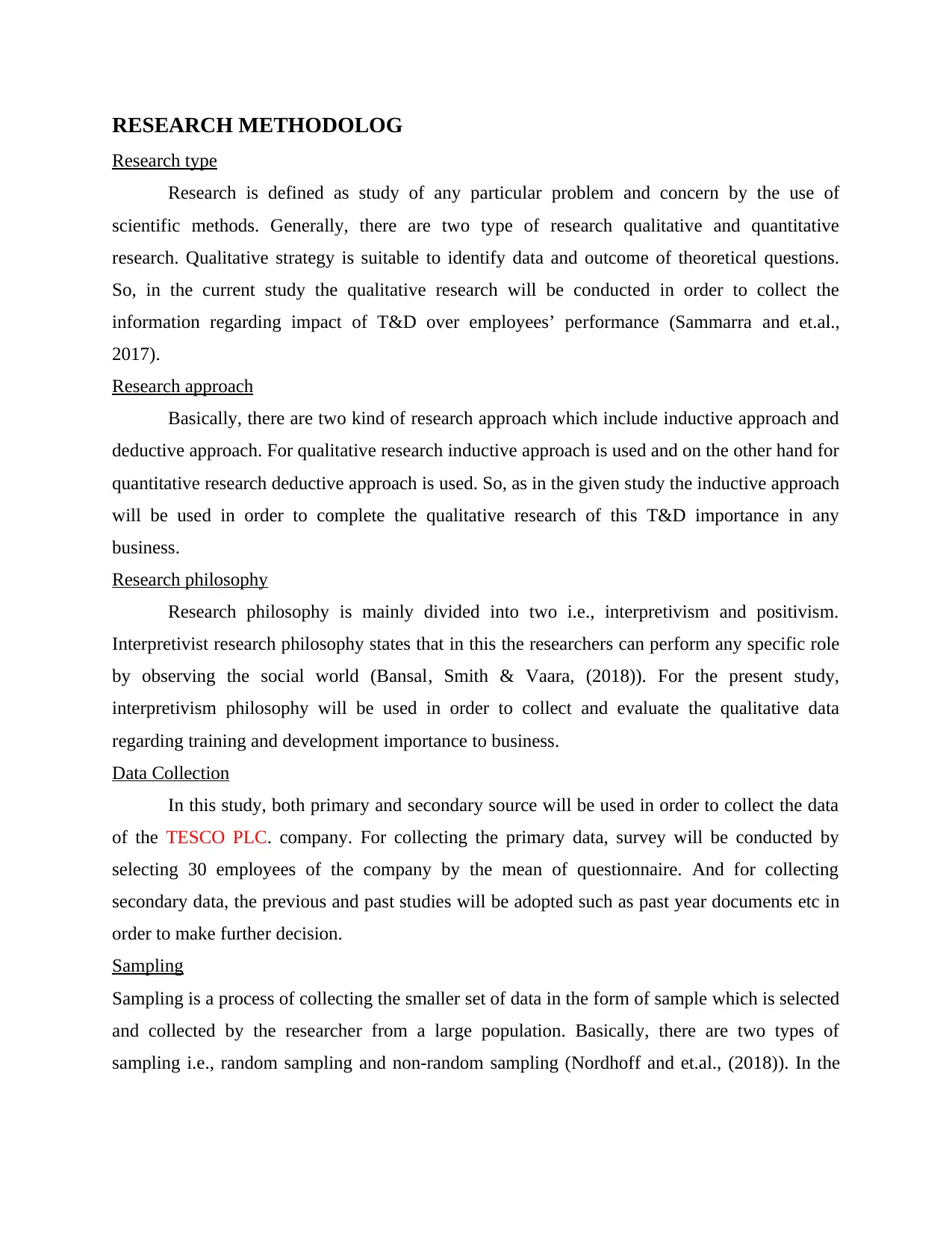
RESEARCH METHODOLOG
Research type
Research is defined as study of any particular problem and concern by the use of
scientific methods. Generally, there are two type of research qualitative and quantitative
research. Qualitative strategy is suitable to identify data and outcome of theoretical questions.
So, in the current study the qualitative research will be conducted in order to collect the
information regarding impact of T&D over employees’ performance (Sammarra and et.al.,
2017).
Research approach
Basically, there are two kind of research approach which include inductive approach and
deductive approach. For qualitative research inductive approach is used and on the other hand for
quantitative research deductive approach is used. So, as in the given study the inductive approach
will be used in order to complete the qualitative research of this T&D importance in any
business.
Research philosophy
Research philosophy is mainly divided into two i.e., interpretivism and positivism.
Interpretivist research philosophy states that in this the researchers can perform any specific role
by observing the social world (Bansal, Smith & Vaara, (2018)). For the present study,
interpretivism philosophy will be used in order to collect and evaluate the qualitative data
regarding training and development importance to business.
Data Collection
In this study, both primary and secondary source will be used in order to collect the data
of the TESCO PLC. company. For collecting the primary data, survey will be conducted by
selecting 30 employees of the company by the mean of questionnaire. And for collecting
secondary data, the previous and past studies will be adopted such as past year documents etc in
order to make further decision.
Sampling
Sampling is a process of collecting the smaller set of data in the form of sample which is selected
and collected by the researcher from a large population. Basically, there are two types of
sampling i.e., random sampling and non-random sampling (Nordhoff and et.al., (2018)). In the
Research type
Research is defined as study of any particular problem and concern by the use of
scientific methods. Generally, there are two type of research qualitative and quantitative
research. Qualitative strategy is suitable to identify data and outcome of theoretical questions.
So, in the current study the qualitative research will be conducted in order to collect the
information regarding impact of T&D over employees’ performance (Sammarra and et.al.,
2017).
Research approach
Basically, there are two kind of research approach which include inductive approach and
deductive approach. For qualitative research inductive approach is used and on the other hand for
quantitative research deductive approach is used. So, as in the given study the inductive approach
will be used in order to complete the qualitative research of this T&D importance in any
business.
Research philosophy
Research philosophy is mainly divided into two i.e., interpretivism and positivism.
Interpretivist research philosophy states that in this the researchers can perform any specific role
by observing the social world (Bansal, Smith & Vaara, (2018)). For the present study,
interpretivism philosophy will be used in order to collect and evaluate the qualitative data
regarding training and development importance to business.
Data Collection
In this study, both primary and secondary source will be used in order to collect the data
of the TESCO PLC. company. For collecting the primary data, survey will be conducted by
selecting 30 employees of the company by the mean of questionnaire. And for collecting
secondary data, the previous and past studies will be adopted such as past year documents etc in
order to make further decision.
Sampling
Sampling is a process of collecting the smaller set of data in the form of sample which is selected
and collected by the researcher from a large population. Basically, there are two types of
sampling i.e., random sampling and non-random sampling (Nordhoff and et.al., (2018)). In the
⊘ This is a preview!⊘
Do you want full access?
Subscribe today to unlock all pages.

Trusted by 1+ million students worldwide
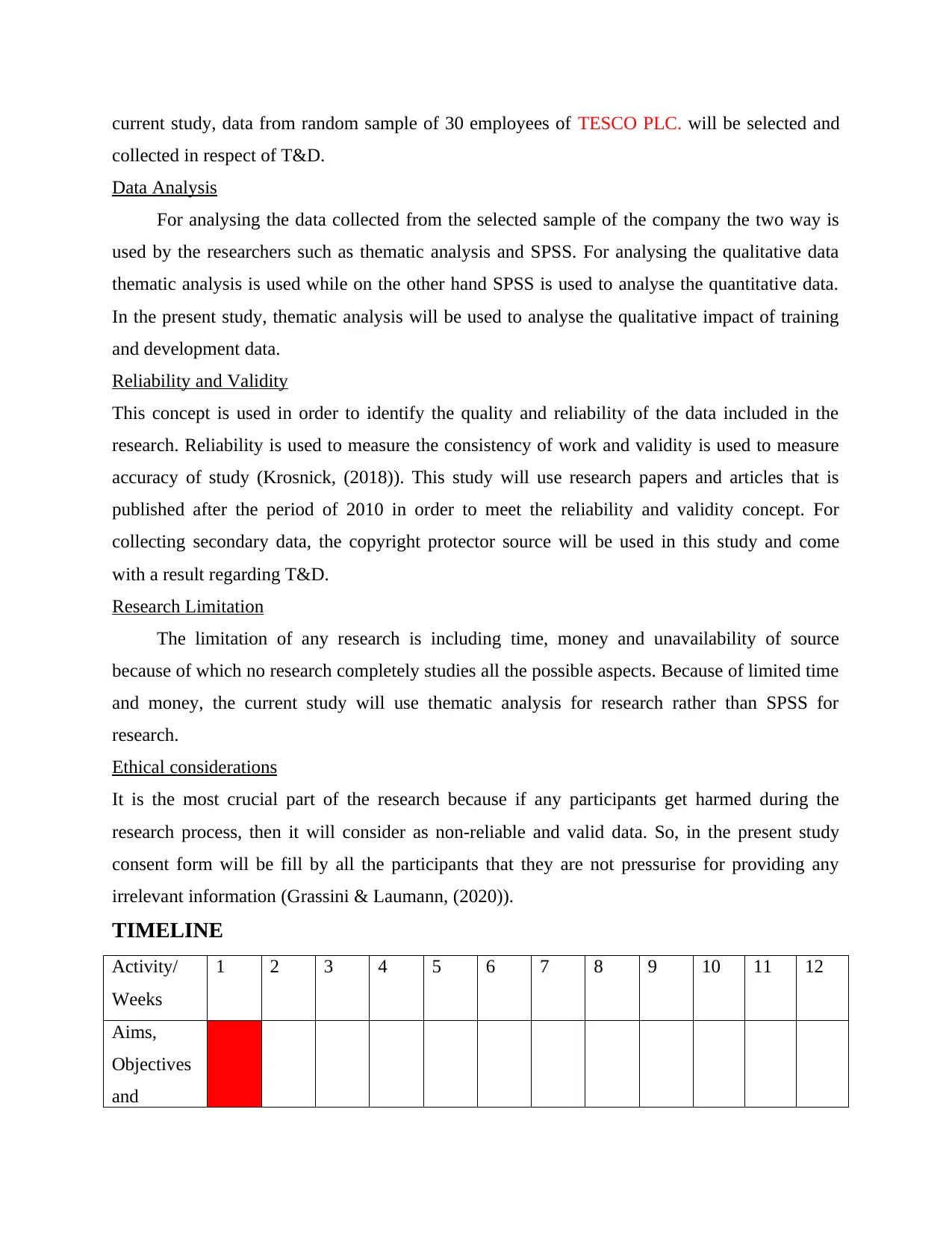
current study, data from random sample of 30 employees of TESCO PLC. will be selected and
collected in respect of T&D.
Data Analysis
For analysing the data collected from the selected sample of the company the two way is
used by the researchers such as thematic analysis and SPSS. For analysing the qualitative data
thematic analysis is used while on the other hand SPSS is used to analyse the quantitative data.
In the present study, thematic analysis will be used to analyse the qualitative impact of training
and development data.
Reliability and Validity
This concept is used in order to identify the quality and reliability of the data included in the
research. Reliability is used to measure the consistency of work and validity is used to measure
accuracy of study (Krosnick, (2018)). This study will use research papers and articles that is
published after the period of 2010 in order to meet the reliability and validity concept. For
collecting secondary data, the copyright protector source will be used in this study and come
with a result regarding T&D.
Research Limitation
The limitation of any research is including time, money and unavailability of source
because of which no research completely studies all the possible aspects. Because of limited time
and money, the current study will use thematic analysis for research rather than SPSS for
research.
Ethical considerations
It is the most crucial part of the research because if any participants get harmed during the
research process, then it will consider as non-reliable and valid data. So, in the present study
consent form will be fill by all the participants that they are not pressurise for providing any
irrelevant information (Grassini & Laumann, (2020)).
TIMELINE
Activity/
Weeks
1 2 3 4 5 6 7 8 9 10 11 12
Aims,
Objectives
and
collected in respect of T&D.
Data Analysis
For analysing the data collected from the selected sample of the company the two way is
used by the researchers such as thematic analysis and SPSS. For analysing the qualitative data
thematic analysis is used while on the other hand SPSS is used to analyse the quantitative data.
In the present study, thematic analysis will be used to analyse the qualitative impact of training
and development data.
Reliability and Validity
This concept is used in order to identify the quality and reliability of the data included in the
research. Reliability is used to measure the consistency of work and validity is used to measure
accuracy of study (Krosnick, (2018)). This study will use research papers and articles that is
published after the period of 2010 in order to meet the reliability and validity concept. For
collecting secondary data, the copyright protector source will be used in this study and come
with a result regarding T&D.
Research Limitation
The limitation of any research is including time, money and unavailability of source
because of which no research completely studies all the possible aspects. Because of limited time
and money, the current study will use thematic analysis for research rather than SPSS for
research.
Ethical considerations
It is the most crucial part of the research because if any participants get harmed during the
research process, then it will consider as non-reliable and valid data. So, in the present study
consent form will be fill by all the participants that they are not pressurise for providing any
irrelevant information (Grassini & Laumann, (2020)).
TIMELINE
Activity/
Weeks
1 2 3 4 5 6 7 8 9 10 11 12
Aims,
Objectives
and
Paraphrase This Document
Need a fresh take? Get an instant paraphrase of this document with our AI Paraphraser
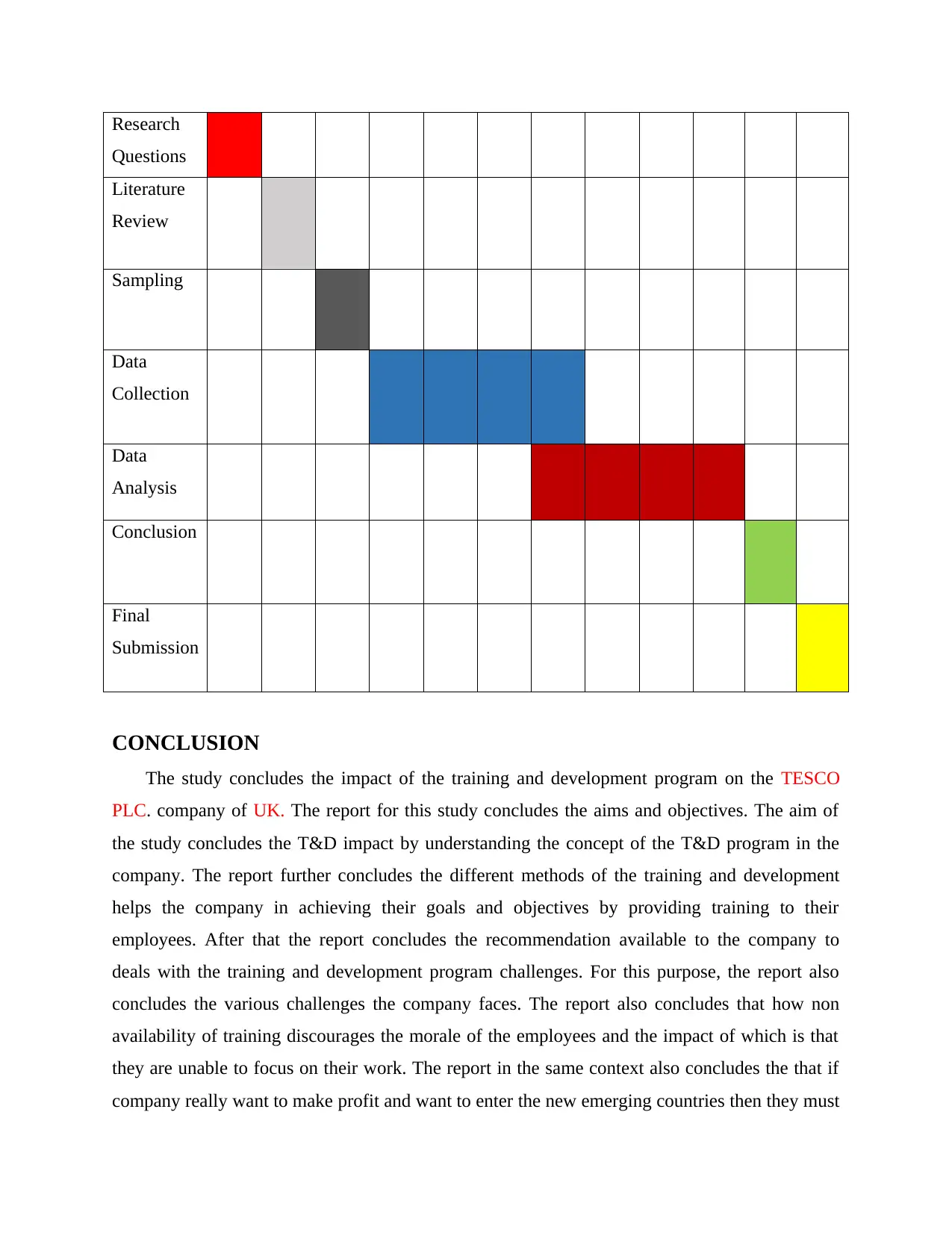
Research
Questions
Literature
Review
Sampling
Data
Collection
Data
Analysis
Conclusion
Final
Submission
CONCLUSION
The study concludes the impact of the training and development program on the TESCO
PLC. company of UK. The report for this study concludes the aims and objectives. The aim of
the study concludes the T&D impact by understanding the concept of the T&D program in the
company. The report further concludes the different methods of the training and development
helps the company in achieving their goals and objectives by providing training to their
employees. After that the report concludes the recommendation available to the company to
deals with the training and development program challenges. For this purpose, the report also
concludes the various challenges the company faces. The report also concludes that how non
availability of training discourages the morale of the employees and the impact of which is that
they are unable to focus on their work. The report in the same context also concludes the that if
company really want to make profit and want to enter the new emerging countries then they must
Questions
Literature
Review
Sampling
Data
Collection
Data
Analysis
Conclusion
Final
Submission
CONCLUSION
The study concludes the impact of the training and development program on the TESCO
PLC. company of UK. The report for this study concludes the aims and objectives. The aim of
the study concludes the T&D impact by understanding the concept of the T&D program in the
company. The report further concludes the different methods of the training and development
helps the company in achieving their goals and objectives by providing training to their
employees. After that the report concludes the recommendation available to the company to
deals with the training and development program challenges. For this purpose, the report also
concludes the various challenges the company faces. The report also concludes that how non
availability of training discourages the morale of the employees and the impact of which is that
they are unable to focus on their work. The report in the same context also concludes the that if
company really want to make profit and want to enter the new emerging countries then they must
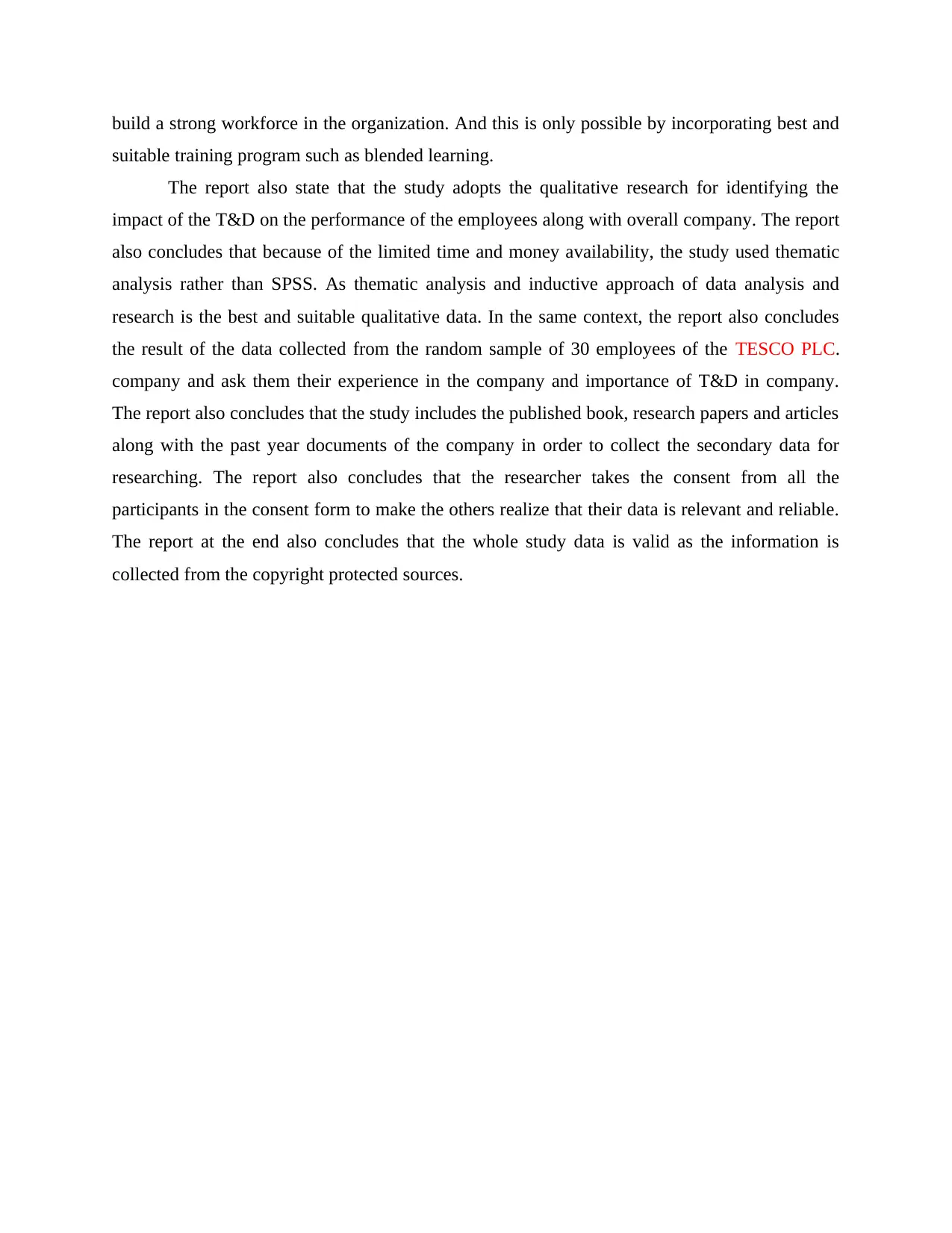
build a strong workforce in the organization. And this is only possible by incorporating best and
suitable training program such as blended learning.
The report also state that the study adopts the qualitative research for identifying the
impact of the T&D on the performance of the employees along with overall company. The report
also concludes that because of the limited time and money availability, the study used thematic
analysis rather than SPSS. As thematic analysis and inductive approach of data analysis and
research is the best and suitable qualitative data. In the same context, the report also concludes
the result of the data collected from the random sample of 30 employees of the TESCO PLC.
company and ask them their experience in the company and importance of T&D in company.
The report also concludes that the study includes the published book, research papers and articles
along with the past year documents of the company in order to collect the secondary data for
researching. The report also concludes that the researcher takes the consent from all the
participants in the consent form to make the others realize that their data is relevant and reliable.
The report at the end also concludes that the whole study data is valid as the information is
collected from the copyright protected sources.
suitable training program such as blended learning.
The report also state that the study adopts the qualitative research for identifying the
impact of the T&D on the performance of the employees along with overall company. The report
also concludes that because of the limited time and money availability, the study used thematic
analysis rather than SPSS. As thematic analysis and inductive approach of data analysis and
research is the best and suitable qualitative data. In the same context, the report also concludes
the result of the data collected from the random sample of 30 employees of the TESCO PLC.
company and ask them their experience in the company and importance of T&D in company.
The report also concludes that the study includes the published book, research papers and articles
along with the past year documents of the company in order to collect the secondary data for
researching. The report also concludes that the researcher takes the consent from all the
participants in the consent form to make the others realize that their data is relevant and reliable.
The report at the end also concludes that the whole study data is valid as the information is
collected from the copyright protected sources.
⊘ This is a preview!⊘
Do you want full access?
Subscribe today to unlock all pages.

Trusted by 1+ million students worldwide
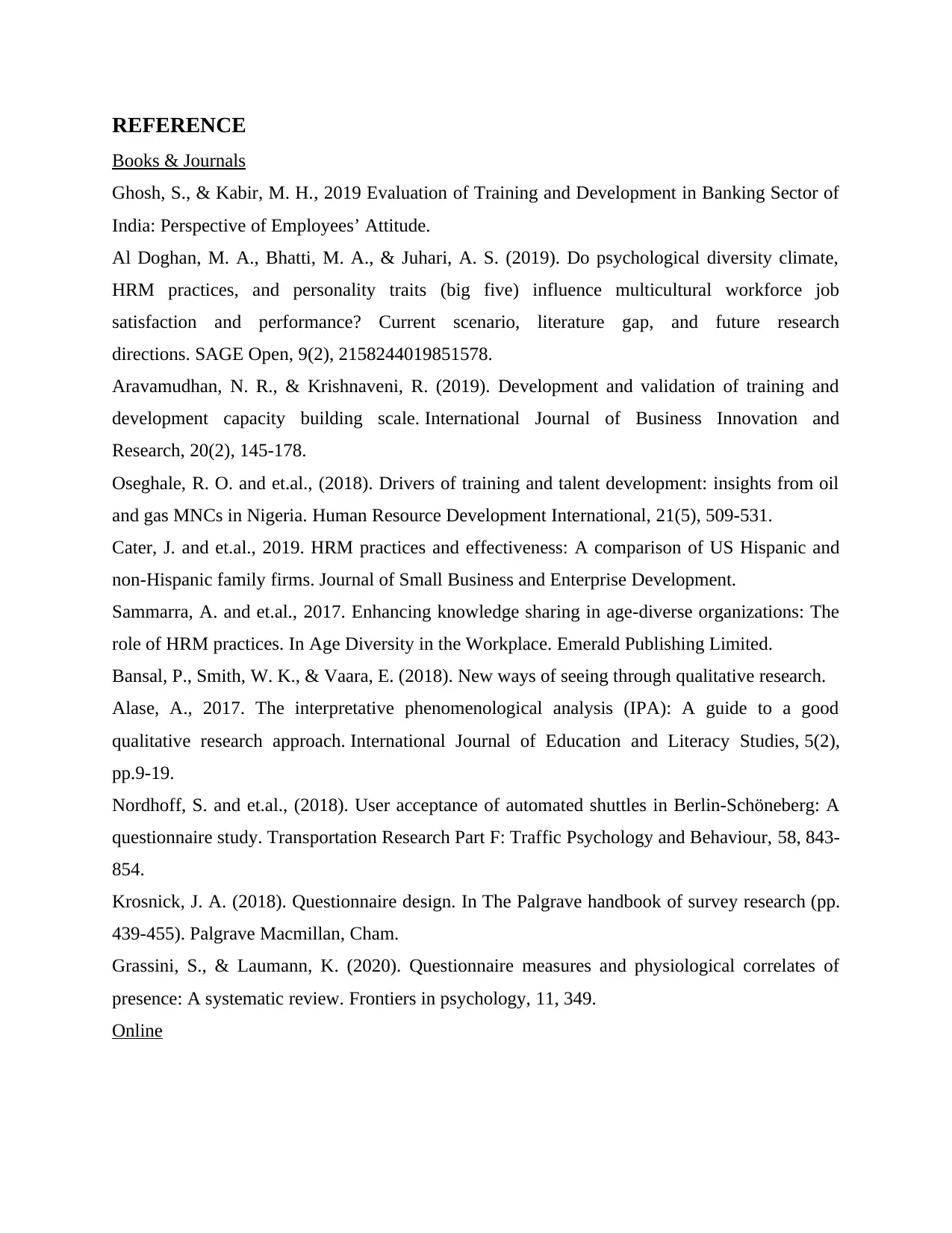
REFERENCE
Books & Journals
Ghosh, S., & Kabir, M. H., 2019 Evaluation of Training and Development in Banking Sector of
India: Perspective of Employees’ Attitude.
Al Doghan, M. A., Bhatti, M. A., & Juhari, A. S. (2019). Do psychological diversity climate,
HRM practices, and personality traits (big five) influence multicultural workforce job
satisfaction and performance? Current scenario, literature gap, and future research
directions. SAGE Open, 9(2), 2158244019851578.
Aravamudhan, N. R., & Krishnaveni, R. (2019). Development and validation of training and
development capacity building scale. International Journal of Business Innovation and
Research, 20(2), 145-178.
Oseghale, R. O. and et.al., (2018). Drivers of training and talent development: insights from oil
and gas MNCs in Nigeria. Human Resource Development International, 21(5), 509-531.
Cater, J. and et.al., 2019. HRM practices and effectiveness: A comparison of US Hispanic and
non-Hispanic family firms. Journal of Small Business and Enterprise Development.
Sammarra, A. and et.al., 2017. Enhancing knowledge sharing in age-diverse organizations: The
role of HRM practices. In Age Diversity in the Workplace. Emerald Publishing Limited.
Bansal, P., Smith, W. K., & Vaara, E. (2018). New ways of seeing through qualitative research.
Alase, A., 2017. The interpretative phenomenological analysis (IPA): A guide to a good
qualitative research approach. International Journal of Education and Literacy Studies, 5(2),
pp.9-19.
Nordhoff, S. and et.al., (2018). User acceptance of automated shuttles in Berlin-Schöneberg: A
questionnaire study. Transportation Research Part F: Traffic Psychology and Behaviour, 58, 843-
854.
Krosnick, J. A. (2018). Questionnaire design. In The Palgrave handbook of survey research (pp.
439-455). Palgrave Macmillan, Cham.
Grassini, S., & Laumann, K. (2020). Questionnaire measures and physiological correlates of
presence: A systematic review. Frontiers in psychology, 11, 349.
Online
Books & Journals
Ghosh, S., & Kabir, M. H., 2019 Evaluation of Training and Development in Banking Sector of
India: Perspective of Employees’ Attitude.
Al Doghan, M. A., Bhatti, M. A., & Juhari, A. S. (2019). Do psychological diversity climate,
HRM practices, and personality traits (big five) influence multicultural workforce job
satisfaction and performance? Current scenario, literature gap, and future research
directions. SAGE Open, 9(2), 2158244019851578.
Aravamudhan, N. R., & Krishnaveni, R. (2019). Development and validation of training and
development capacity building scale. International Journal of Business Innovation and
Research, 20(2), 145-178.
Oseghale, R. O. and et.al., (2018). Drivers of training and talent development: insights from oil
and gas MNCs in Nigeria. Human Resource Development International, 21(5), 509-531.
Cater, J. and et.al., 2019. HRM practices and effectiveness: A comparison of US Hispanic and
non-Hispanic family firms. Journal of Small Business and Enterprise Development.
Sammarra, A. and et.al., 2017. Enhancing knowledge sharing in age-diverse organizations: The
role of HRM practices. In Age Diversity in the Workplace. Emerald Publishing Limited.
Bansal, P., Smith, W. K., & Vaara, E. (2018). New ways of seeing through qualitative research.
Alase, A., 2017. The interpretative phenomenological analysis (IPA): A guide to a good
qualitative research approach. International Journal of Education and Literacy Studies, 5(2),
pp.9-19.
Nordhoff, S. and et.al., (2018). User acceptance of automated shuttles in Berlin-Schöneberg: A
questionnaire study. Transportation Research Part F: Traffic Psychology and Behaviour, 58, 843-
854.
Krosnick, J. A. (2018). Questionnaire design. In The Palgrave handbook of survey research (pp.
439-455). Palgrave Macmillan, Cham.
Grassini, S., & Laumann, K. (2020). Questionnaire measures and physiological correlates of
presence: A systematic review. Frontiers in psychology, 11, 349.
Online
Paraphrase This Document
Need a fresh take? Get an instant paraphrase of this document with our AI Paraphraser

The Importance of Training & Development in the Workplace. 2021 [Online]. Available
through:< https://smallbusiness.chron.com/importance-training-development-workplace-
10321.html>
through:< https://smallbusiness.chron.com/importance-training-development-workplace-
10321.html>
1 out of 11
Related Documents
Your All-in-One AI-Powered Toolkit for Academic Success.
+13062052269
info@desklib.com
Available 24*7 on WhatsApp / Email
![[object Object]](/_next/static/media/star-bottom.7253800d.svg)
Unlock your academic potential
Copyright © 2020–2025 A2Z Services. All Rights Reserved. Developed and managed by ZUCOL.





